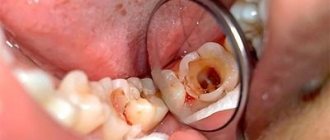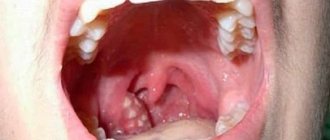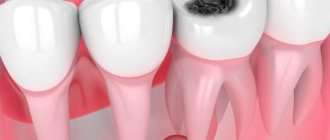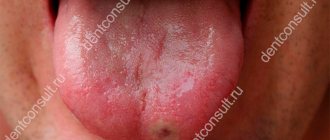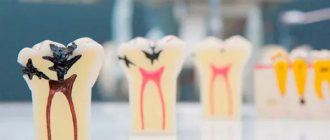If your teeth are not treated in time, unpleasant and dangerous consequences arise. In 50% of cases, the complication of caries turns into inflammation of the pulp or periodontitis. The latter, if not treated in a timely manner, takes a chronic course.
Chronic periodontitis is a pathology with a protracted inflammatory nature, located in the periapical area, in which destruction of dental tissue occurs. This disease leads to damage to the connecting elements that hold the tooth, resorption of the alveolar plate and bone tissue. In most cases, the disease attacks people over 50 years of age.
Chronic forms of periodontitis
This disease has virtually no symptoms. Signs appear if there is an exacerbation of the disease as a result of colds and hypothermia.
It is customary to distinguish three forms of this anomaly:
Chronic fibrous periodontitis
With this form, the fibrous part of the periodontium is transformed into fibrous ligaments. Symptoms of the disease are almost absent, as well as painful sensations.
Chronic fibrous periodontitis is diagnosed only with an x-ray. Normally, periodontitis looks like a narrow, even strip that divides the root and alveolus of the bone. The fibrous form is characterized by an enlarged gap in the periodontal area.
Chronic granulating periodontitis
The most aggressive form, which is expressed as loose red tissue at the apex of the root. It grows quickly and also quickly destroys bone, transforming it into a granulation substance.
The patient is bothered by aching pain, there is pain when biting a tooth, and a fistula often occurs on the gum.
In the picture, chronic granulating periodontitis has bright features. At the top of the root there are darkened areas that confirm the breakdown of bone tissue, in the place of which granulation tissue has already arisen.
Chronic granulomatous periodontitis
Externally, the disease manifests itself as a piece of mucous membrane in the form of a sac, which is called a “periodontal abscess.” There is pus inside the sac. Depending on the size, there are three types of this form:
- Less than a centimeter is a granuloma.
- From half a centimeter to 1 cm – cystogranuloma.
- More than a centimeter is a cyst.
At the onset of the disease, there are often no symptoms. As the dental system is attacked, the sensations when biting or tapping on a tooth increase.
In the picture, chronic granulomatous periodontitis is determined by a darkened area at the top of the root, which has an even outline in the form of a circle. It was in this place that the resorption of the bone tissue occurred.
Chronic apical periodontitis
Also asymptomatic. The patient begins to suspect a problem when the pulp has already reached the stage of necrosis, the color of the tooth has changed, and there is discomfort when chewing. Chronic apical periodontitis is diagnosed exclusively with the help of an x-ray, which shows a noticeable expansion of the periodontal type gap at the top of the root.
Possible complications
- Death of the rudiment if the pathology spreads before mineralization begins.
- With prolonged inflammation, the root of a temporary tooth is exposed.
- Change in the position of the follicle in the jaw.
- Local enamel hypoplasia due to infection of the follicle at the beginning of mineralization.
- Destruction of the bone tissue septum between the primary periodontium and the germ of permanent teeth.
- Follicular cyst.
- Delayed eruption of permanent teeth.
- Formation of dental anomalies due to premature removal of milk.
Exacerbation of chronic periodontitis
At this stage, all symptoms resemble the acute form. There is sharp pain, swelling and growth of lymph nodes. Considering that a chronic disease leads to bone destruction, during an exacerbation there is a risk of exudate getting inside the jaw. There is a possibility of a fistula.
The patient feels weak, his body temperature rises, and complaints of feeling cold arise.
What exactly are the consequences if chronic periodontitis worsens?
- Violation of the integrity of a periodontal type abscess. In the case of granulomatous periodontitis, the inflammatory area has boundaries of strong fibrous tissue in the form of a bag of pus. Excessive load on the tooth negatively affects the infected lesion, which is at rest. As a result, the pressure increases and the capsule ruptures, and the infection goes beyond the limits, leading to an exacerbation.
- Improper drainage of purulent contents. With granulomatous and granulating forms, pus is continuously discharged. However, it successfully exits through a fistula or root canals, ending up in the area of caries. Thus, the patient does not feel discomfort. But when the exits are closed, the pus accumulates, bursts and becomes inflamed. Pain and swelling occur.
- Reduced protective properties of the body. As a result, all those factors that previously prevented periodontal infections from growing and developing no longer carry out their main protective function. The infection is spreading on a large scale.
Temporary filling
During a second visit to a dentist-therapist during the course of treatment of chronic periodontitis, the area of manipulation is examined. The specialist will also clarify whether the patient has any complaints of pain, swelling in the gum area or other discomfort. If such negative phenomena are not observed, temporary filling of the dental canals is performed.
For this purpose, the temporary filling is initially removed, as well as the antiseptic placed in the tooth canals. The canal openings are thoroughly washed with an antiseptic and then filled with a special type of composite material used for temporary filling. This composite contains calcium hydroxide, a substance that destroys pathogenic microflora and also catalyzes the process of bone tissue regeneration in the area of the upper zone of the tooth root. Temporary filling of canal cavities is done for a fairly long period - from two to three months. The dentist then places a temporary filling in the crown of the tooth.
Indications for treatment
The following indications exist for conservative treatment:
- Periodontitis of acute and chronic forms of single-rooted teeth, when the periapical tissues have not undergone large-scale changes.
- Periodontitis of acute and chronic forms of multi-rooted teeth, subject to patency of the canals and the absence of an irreversible process in the periapical tissues.
How is periodontitis eliminated? Treatment of the disease at the chronic stage
Regardless of the form, the root cause must be addressed first. To do this, the doctor works in the main root canal and its branches, as well as in the periodontium itself. If exudate is present, it must be quickly released. At the end of treatment, the gap between the periodontium and the root canals is carefully sealed.
Clinical researches
Clinical studies have shown that for the treatment of chronic localized periodontal disease of traumatic etiology in young patients, a complex of therapeutic and preventive measures is required, which includes domestic gum balm and gum gel with propolis (JSC VERTEX, Russia), as well as personal hygiene products oral cavity in the form of therapeutic and prophylactic toothpaste "ASEPTA PARODONTAL SENSITIVE" (JSC "VERTEX", Russia) and mouth rinses "ASEPTA PARODONTAL ACTIVE" and "ASEPTA PARODONTAL FRESH", (JSC "VERTEX", Russia), which allows within 6 months after completion of complex treatment, not only improve oral hygiene and reduce inflammatory processes in the gums by 55.37%, but also reduce the number of relapses of localized periodontitis by 21.36%.
To increase the effectiveness of treatment of chronic localized periodontitis of traumatic etiology in young people, it is advisable to include a gum balm in the complex of treatment and preventive measures, which should be used after completion of the surgical stage (curettage) as a gingival dressing, and subsequently used to optimize gum regeneration, gum gel with propolis, should be used against the background of adequate individual oral hygiene.
Sources:
- Prevention of recurrence of localized periodontitis in young A.K. YORDANISHVILI, Doctor of Medical Sciences, Professor, North-Western State Medical University named after. I.I. Mechnikov, Military Medical Academy named after. CM. Kirov, International Academy of Sciences of Ecology, Human Safety and Nature.
- Report on clinical trials to determine/confirm the preventive properties of commercially produced personal oral hygiene products: mouth rinse "ASEPTA PARODONTAL" - Solution for irrigator." Doctor of Medical Sciences Professor, Honored Doctor of the Russian Federation, Head. Department of Preventive Dentistry S.B. Ulitovsky, doctor-researcher A.A. Leontiev First St. Petersburg State Medical University named after academician I.P. Pavlova, Department of Preventive Dentistry.
- Clinical studies of antisensitive toothpaste “Asepta Sensitive” (A.A. Leontyev, O.V. Kalinina, S.B. Ulitovsky) A.A. LEONTIEV, dentist O.V. KALININA, dentist S.B. ULITOVSKY, Doctor of Medical Sciences, Prof. Department of Therapeutic Dentistry, St. Petersburg State Medical University named after. acad. I.P. Pavlova
Therapeutic treatment
Chronic periodontitis is often successfully treated with therapy. To do this, the carious area is prepared and the old filling is removed. Continuous treatment of the affected area with an antiseptic is mandatory. After removing the old filling, measures will be needed to ensure the unimpeded outflow of exudate and rinsing the cavity with an antiseptic.
The following measures will help enhance the effect:
- Phonophoresis with the introduction of an antiseptic under the influence of ultrasound into microtubules.
- Electrophoresis with potassium iodide and other antiseptics, in which molecules quickly form polarized ions.
- Laser treatment. The laser affects the disease in two ways at once: it sterilizes the root canal, removing bacteria, and releases special oxidizing agents that arise under the influence of radiation from more complex molecules as a result of their breakdown.
Elimination of the disease at the acute stage is carried out, starting with the demobilization of the factors that led to this condition. Antiseptic is not enough for this. Good drainage will be required, as well as antibacterial therapy.
When the root cause of the exacerbation is destroyed, with granulating periodontitis the doctor acts on the tissue using various means (calcium hydroxide). The same measures are taken in the case of the granulation form.
At the end of therapy, the tooth is sealed, as well as the canal is filled, if the patient has no complaints.
Inspection and primary treatment of dental canal cavities
Treatment of periodontitis begins with a thorough examination of the patient by a dentist, after which the specialist prescribes an x-ray for the patient. The image will help make the diagnosis as accurately as possible, as well as study in detail the number of dental canals, their length and shape. Next, an anesthetic injection is made into the area of the diseased tooth, without which treatment of periodontitis can be a very painful and uncomfortable process for the patient.
After the drug takes effect, the doctor will perform the following manipulations:
- It will remove from the diseased dental unit all tissues damaged by the carious process, as well as some healthy enamel and dentin. This is necessary to gain access to the mouths of the dental canals;
- If the tooth has not been treated before, the doctor will remove the inflamed pulp from it. If treatment of the unit with the removal of nerves has previously been carried out, the tooth canals are unfilled;
- Expand the tooth canals manually, using specialized instruments for this purpose. After expansion, the tooth canals are thoroughly washed with an antibacterial solution;
- Place a medicine with enhanced antiseptic action into the channels.
After applying the antiseptic to the dental unit, a temporary filling is installed, and the specialist thoroughly advises the patient on oral care, prescribes anti-inflammatory drugs and medications that reduce the risk of allergic reactions. The next time you will need to visit the doctor approximately three days after completing the first stage of periodontitis treatment.
Surgery
If the granuloma is large and cannot be removed therapeutically, it becomes necessary to resect the upper part of the root. To do this, the canal is filled with materials that quickly harden but do not dissolve. It is allowed to use the material in excess, since the doctor will remove it later. During the operation, high-quality anesthesia will be required. The dentist cuts the gum and widens the area of the jaw where the granuloma is present. At the site of destruction, the bone and part of the root are cut out and the granulation is scraped out. Instead, an antibacterial substance is compacted and the wound is sutured. It is recommended to install drainage for a day.
There are situations when the entire tooth needs to be removed. Reasons include obstruction of the root canals, lack of treatment effect, closely located mandibular canal, etc. After removal, the inflamed area goes away on its own. But there are cases when it is necessary to make an incision, disconnect the periosteum and install drainage. This manipulation is carried out when there is an accumulation of pus that did not come out during tooth extraction.
Temporary and permanent root canal filling
After the operation to remove pus for acute periodontitis, 3-4 days should pass, and then the patient visits the clinic again. During the second appointment, the doctor performs the following manipulations:
1. Thoroughly rinses the canal cavities with antibacterial solutions, and then puts an antiseptic in them.
2. Places a temporary filling on the tooth.
The patient is sent home, but is warned: at the slightest sign of pain, he should immediately seek professional dental care.
Permanent filling of the canals is carried out during the third visit. The treatment procedure can be carried out in the absence of complaints from the patient about any discomfort, as well as in the complete absence of pus in the canal cavities. The canals are filled with gutta-percha composite to the upper root zone. Restoration of the aesthetics and functionality of the tooth is done on a subsequent visit, and at this point the course of periodontitis treatment is considered complete.
Contraindications to treatment
Absolute contraindications for this type of treatment include:
- Severe changes in periapical tissues (cyst, cystogranuloma) with the presence of focally caused ailments.
- Obstruction of the canals at the acute stage.
- Tooth mobility of 1I-IV degrees, when the alveolar arch at the level of the diseased tooth has atrophied.
- Cysts of peri-root teeth with root penetration into the pathological process.
- Irreversibility of the course of the disease and the impossibility of performing post-apical therapy.
- Perforation of a cavity or tooth root.
What is the cost of treatment?
The price depends on the complexity of the work and the number of channels. The following are approximate prices taking into account three-stage treatment. At the fourth stage, a permanent filling is installed.
The first visit includes the following activities:
- Preparation of a carious cavity.
- Pulp removal.
- X-ray.
- Channel processing.
- Applying an antiseptic.
- Installation of a temporary filling.
The cost of an appointment for treatment of a single-canal tooth is from 1 thousand rubles.
Subject to dual-channel treatment – from 1.5 thousand rubles.
Three-channel – from 1.8 thousand rubles.
On the second visit, the following manipulations are performed:
- Removal of temporary filling and antiseptic.
- Flushing the cavity.
- Application of medicinal material.
- Installation of a temporary filling.
The cost of an appointment for treatment of a single-canal tooth is from 800 rubles.
Two-channel – from 1000 rubles.
Three-channel – from 1.5 thousand rubles.
The third visit includes the following procedures:
- Removal of temporary filling and therapeutic material.
- Treatment with an antiseptic substance.
- Canal filling.
- X-ray.
- Installation of a temporary filling.
The cost of the third visit, subject to treatment of a single-canal tooth, starts from 0.9 thousand rubles.
Two-channel – from 1.2 thousand rubles.
Three-channel – from 1.5 thousand rubles. ,
At the fourth visit, the doctor will install a permanent filling. Its cost is from 2 thousand rubles, depending on how badly the crown is damaged.
Third visit
In addition to a visual examination, the doctor will need an x-ray to examine the quality of the therapy and make sure that the abscess is not growing. Having seen a positive result with traces of bone restoration, the doctor either proceeds to install permanent fillings or decides to continue treatment.
If the outcome is favorable, the dentist cleans the tubules from the substrate that temporarily fills them, rinses, disinfects and carefully seals with gutta-percha to the very top.
Finally, an x-ray is taken to show how well the tooth canals are filled. If the filling material extends beyond the apex or does not reach it, the doctor's work was in vain. The channels will have to be redone. In the opposite case, periodontitis recurs with the same force.
A temporary filling is placed for the third time.
How to prevent the development of the disease? Prevention
The main preventative point is the treatment of caries immediately after the onset of dental problems. The infection enters the periodontium through the carious area. To prevent marginal or marginal types of disease, in which the infection passes through the deep periodontal areas, it is important to monitor the condition of the gums. Periodontal treatment immediately after its appearance, as well as timely removal of tartar, is of great importance.
Acute forms of the disease are eliminated using an integrated approach to treatment in order to prevent the anomaly from moving to the chronic stage. This rule fully depends on the qualifications of the doctor and the availability of high-quality equipment in the clinic.
Causes of the disease
The main reason for the development of the disease is a chronic inflammatory process due to an advanced form of pulpitis or carious lesions. Other reasons may be injuries to the dentition due to mechanical impact, for example, when biting hard foods or during a fall or impact.
Also, the body’s reaction to incorrectly formulated drug treatment and incorrectly selected dental braces can also be expressed by inflammation in the gum area. An exacerbation of the process occurs in the presence of endocrine diseases, as well as a lack of vitamins and minerals in the body, reduced immunity.
